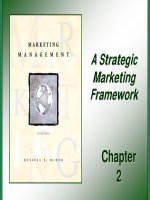Marketing lecture Chapter 1
Bạn đang xem bản rút gọn của tài liệu. Xem và tải ngay bản đầy đủ của tài liệu tại đây (501.32 KB, 27 trang )
Chapter
Chapter 11
Marketing in a Changing World:
Creating Customer Value and
Satisfaction
What
What is
is Marketing?
Marketing?
• Process by which individuals and
groups obtain what they need and want
through creating and exchanging
products and value with others.
• More simply: Marketing is the delivery
of customer satisfaction at a profit.
Core
Core Marketing
Marketing
Concepts
Concepts
Needs, wants,
and demands
Products
and
Services
Core
Core
Marketing
Marketing
Concepts
Concepts
Markets
Value, satisfaction,
and quality
Exchange, transactions,
and relationships
Emergence of the Marketing Concept
• Occurred during the shift from a sellers’ market to a buyer’s market after
World War II.
• Created the need for greater consumer orientation.
• Business philosophy incorporating the marketing concept that
emphasizes first determining unmet consumer needs and then
designing a system for satisfying them.
• Marketing concept Company-wide consumer orientation for achieving
long-term success.
• Example: Apple computer, which polls show “delivers great consumer
experiences with outstanding design.”
• Relationship marketing Developing and maintaining of long-term, costeffective relationships with individual customers, suppliers, employees, and
other partners for mutual benefit.
What
What Motivates
Motivates aa Consumer
Consumer
to
to Take
Take Action?
Action?
• Needs - state of felt deprivation for basic items
such as food and clothing and complex needs such
as for belonging. i.e. I am thirsty
• Wants - form that a human need takes as shaped
by culture and individual personality. i.e. I want a
Coca-Cola.
• Demands - human wants backed by buying power.
i.e. I have money to buy a Coca-Cola.
What
What Will
Will Satisfy
Satisfy Consumer’s
Consumer’s
Needs
Needs and
and Wants?
Wants?
• Products - anything that
can be offered to a
market for attention,
acquisition, use or
consumption and that
might satisfy a need or
want.
• Examples: persons,
places, organizations,
activities, and ideas.
• Services - activities or
benefits offered for sale
that are essentially
intangible and don’t
result in the ownership of
anything.
• Examples: banking,
airlines, haircuts, and
hotels.
CONVERTING NEEDS TO WANTS
•Effective marketing focuses on the benefits resulting from
goods and services.
Example: Need for a pair of pants converted to a desire
for jeans.
• Companies must pay attention to what consumers want.
Example: Demand for cell phones and wireless
services.
Number of Wi-Fi Internet users grew 57 percent in a
recent year.
AVOIDING MARKETING MYOPIA
Marketing myopia Management’s failure to recognize the
scope of its business.
How
How Do
Do Consumers
Consumers Choose
Choose
Choose
Choose Among
Among Products
Products and
and
Services?
Services?
• Customer Value - benefit that the customer
gains from owning and using a product
compared to the cost of obtaining the product.
• Customer Satisfaction - depends on the
product’s perceived performance in delivering
value relative to a buyer’s expectations.
Linked to Quality and Total Quality
Management (TQM).
How
How do
do Consumers
Consumers Obtain
Obtain
Products
Products and
and Services?
Services?
• Exchanges - act of obtaining a desired object from
someone by offering something in return.
• Transactions - trade of values between parties.
Usually involves money and a response.
• Relationships - building long-term relationships
with consumers, distributors, dealers, and
suppliers.
Who
Who Purchases
Purchases Products
Products
and
and Services?
Services?
Market
Market -- buyers
buyers
who
who share
share aa
particular
particular need
need
or
or want
want that
that can
can
be
be satisfied
satisfied by
by aa
company’s
company’s products
products
or
or services.
services.
Actual
Actual
Buyers
Buyers
Potential
Potential
Buyers
Buyers
Modern
Modern Marketing
Marketing System
System
Suppliers
Suppliers
Company
Company
(Marketer)
(Marketer)
Marketing
Marketing
Intermediaries
Intermediaries
End
End User
User
Market
Market
Environment
Environment
Competitors
Competitors
Marketing
Marketing Management
Management
Marketing Management
Implementing programs to create exchanges
with target buyers to achieve organizational
goals
Demand Management
Finding and increasing demand, also
changing or reducing demand
Profitable Customer Relationships
Attracting new customers and
retaining current customers
Marketing
Marketing Management
Management
Philosophies
Philosophies
Production
Production Concept
Concept
• Consumers favor products that are
available and highly affordable
•Improve production and distribution
Product
Product Concept
Concept
•Consumers favor products that offer
the most quality, performance, and
innovative features
Selling
Selling Concept
Concept
•Consumers will buy products only if
the company promotes/ sells these
product
Marketing
Marketing Concept
Concept
Societal
Societal Marketing
Marketing Concept
Concept
•Focuses on needs/ wants of target
markets & delivering satisfaction
better than competitors
•Focuses on needs/ wants of target
markets & delivering superior value
•Society’s well-being
Marketing
Marketing &
& Sales
Sales
Concepts
Concepts
Contrasted
Contrasted
Starting
Point
Factory
Focus
Existing
Products
Means
Ends
Selling
and
Promoting
Profits
through
Volume
The
The Selling
Selling Concept
Concept
Market
Customer
Needs
Integrated
Marketing
Profits
through
Satisfaction
The
The Marketing
Marketing Concept
Concept
Societal
Societal Marketing
Marketing Concept
Concept
Society
Society
(Human
(Human Welfare
Welfare))
Societal
Societal
Marketing
Marketing
Concept
Concept
Consumers
Consumers
(Wants)
(Wants)
Company
Company
(Profits)
(Profits)
New
New Marketing
Marketing Challenges
Challenges
New
Marketing
Landscape &
Information
Technology
Ethical
Concerns
Nonprofit
Marketing
Emerging
Emerging
Challenges
Challenges
Changing
World
Economy
Globalizatio
n
EXPANDING THE TRADITIONAL
BOUNDARIES
OF MARKETING
MARKETING IN NOT-FOR-PROFIT ORGANIZATIONS
• 10 percent of U.S. population works or volunteers for a not-forprofit organization.
• Operate in public sector and private sector.
• Not-for-profits sometimes promote their messages through
partnerships with commercial firms.
Example: America’s Second Harvest receiving assistance from
food manufacturers and grocery stores.
NONTRADITIONAL MARKETING
CREATIVITY AND CRITICAL
THINKING
• The challenges of the marketplace require critical thinking
and creativity.
• Creativity produces original ideas or knowledge.
Example: George de Mestral inventing Velcro after
noticing burrs that stuck to his wool socks.
• Critical thinking determines the authenticity, accuracy, and
worth of information, knowledge, claims, and arguments.
Example: Microsoft forming an Internet research lab to
develop and evaluate new products.
TECHNOLOGY REVOLUTION IN
MARKETING
• Technology—The business application of knowledge based on
scientific discoveries, inventions, and innovations.
• Communications technology has revolutionized the way we do
business.
More than half of all U.S. households have at least one
computer.
Internet sales in U.S. topped $143 billion in a recent year.
• Technology also opens new markets.
INTERACTIVE AND INTERNET MARKETING
• Interactive, customizable technology that gives users quick access
to information.
• Interactive marketing—Customer controls amount and type of
information received from a marketer.
FROM TRANSACTION-BASED
MARKETING TO
RELATIONSHIP MARKETING
• View of marketing as transaction-based is being
replaced by a longer-term approach.
• Focus is on developing customers into repeat, loyal
customers.
• Over long-term, increases lifetime value of the
customer.
• Goal is to move customer up the loyalty ladder:
• New customer
• Regular purchaser
• Loyal supporter
• Advocate
• Repeat customers are a source of buzz marketing.
DEVELOPING PARTNERSHIPS AND
STRATEGIC ALLIANCES
• Relationship marketing also applies to business-to-business
relationships with suppliers, distributors, and other partners.
• Strategic alliances Partnerships in which two or more companies
combine resources and capital to create competitive advantages in a
new market.
Example: Yahoo! and TiVo blending some of their services.
• Not-for-profits often raise awareness and funds through strategic
partnerships.
COSTS AND FUNCTIONS OF
MAREKTING
• Marketing costs are typically 40 to 60 percent of total product
costs.
• Marketing performs eight universal functions:
Exchange functions—buying and selling
Physical distribution functions—transporting and storing
Facilitating functions—standardizing and grading,
financing, risk taking, and securing marketing information.









